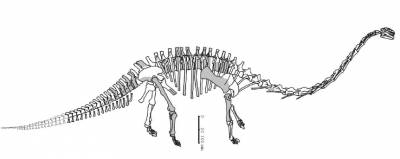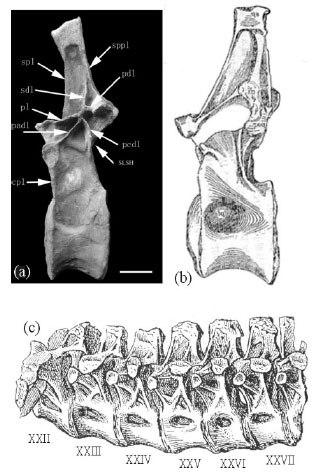Yuanmousaurus Lu, Li, Qiang, Wang, Zhang, and Dong, 2006
Dinosauria>Saurischia>Sauropodomorpha>Sauropoda>Eusauropoda>Euhelopodidae
Etymology: The generic name refers to the Chinese administrative unit Yuanmou, which the holotype locality belongs to; sauros, Greek for lizard, reptile
Yuanmousaurus jiangyiensis Lu, Li, Qiang, Wang, Zhang, and Dong, 2006
Etymology: Jiangyi refers to the holotype locality.
Holotype: An incomplete skeleton without skull, including an antertior part of a cervical vertebra, 9 dorsal vertebrae, two and a half posterior sacral vertebrae, 7 caudal vertebrae, both almost complete scapulae, one nearly complete right humerus, right ulna and radius, partial right ilium, one right complete femur, one right tibia and fibula, one astragalus, one ungual and other bone fragments. The specimen is housed at the Yuanmou Museum, registered No. YMV 601.
Locality and Horizon: Jiangyi, Yuanmou County of Yunnan Province, Zhanghe Formation (Bureau of Geology and Mineral Resources of Yunnan Province, 1990).
Diagnosis: Large-sized euhelopodid dinosaur, dorsal vertebral neural spines with dorsoventrally-oriented cavities, which are demarcated by the parallel anterior margin (supraprezygapophyseal lamina) and posterior margin (suprapostzygophyseal lamina), similar to those of Omeisaurus and Patagosaurus; The structures of the neural arches of the dorsal vertebrae are different from those of Omeisaurus, and each dorsal vertebra bears 9 laminae, forming three cavities on the lateral surface of the neural arches in Yuanmousaurus, while there is no cavities on the lateral surface of the neural arches in Omeisaurus; The deltopectroal crest is narrow, and the ratio of humeral length to femoral length approximately 0.72.

The reconstruction of Yuanmousaurus jiangyiensis gen et sp. nov. Gray elements are those that are preserved.
Abstract: Yuanmousaurus jiangyiensis gen. et sp. nov. is
erected based on an incomplete skeleton. It is characterized by more
complex structures of the neural arches in the dorsal vertebrae than
those in Omeisaurus, but less complex than those of Euhelopus; the
dorsal vertebra bears 9 laminae, forming three cavities on the lateral
surface of the neural arch; the dorsal vertebral neural spines with
dorsoventrally-oriented cavities are similar to those of Omeisaurus and
Patagosaurus. Yuanmousaurus is more primitive than Euhelopus, but more
derived than Omeisaurus. The similar dorsal vertebral structure between
Yuanmousaurus and Patagosaurus may indicate that they have a close
relationship to each other.

Comparison of dorsal vertebrae of Yuanmousaurus (a), Omeisaurus (b) and
Euhelopus (c). Abbreviations: cpl – centroparapophyseal lamina; padl –
paradiapophyseal lamina; pcdl – posterior centrodiapophyseal lamina;
pdl – postzygodiapophyseal lamina; pl – prezygapophyseal lamina; sdl –
Spinodiapophyseal lamina; slsh – a single lamina supporting the
hyposphene; spl – supraprezygapophyseal lamina; sppl –
suprapostzygapophyseall lamina. (a) is from this study, (b) is from He
et al. (1988, reversed), and (c) is from Wiman (1929). Scale bar = 10
cm in (a).
Description: Yuanmousaurus is a large-sized sauropod dinosaur, and the estimated body length is 17 m. Yuanmousaurus is assigned to Euhelopodidae (=Euhelopodinae Romer, 1956), based on the following characters: opsithocoelous dorsal vertebrae with
moderately developed prezygopophysis, caudal vertebrae are procoelous, and a spinodiapophyseal lamina joining the suprapostzygapophyseal lamina as is the case in Euhelopus (Wiman, 1929). Euhelopodidae may include three published Asian forms, Omeisaurus, Euhelopus and Mamenchisaurus (Upchurch, 1998). Yuanmousaurus differs from the primitive eusauropod Shunosaurus which is once regarded as being within the
euhelopodid clade (Dong et al., 1983; Zhang, 1988) in that the cervical vertebrae are short-typed in Shunosaurus, while the cervical vertebrae are elongated in Yuanmousaurus, no pleurocoels (depressions) are present on the lateral surface of the dorsal vertebrae in Shunosaurus, while the pleurocoels are developed in
Yuanmousaurus, the structures of the neural arches of dorsal vertebrae in Shunosaurus is relatively simpler than those of Yuanmousaurus, the ratio of humeral length to femoral length is approximately 0.56 in Shunosaurus (Zhang, 1988), while the ration of the humeral length to femoral length is 0.72 in Yuanmousaurus. It is difficult to compare Yuanmousaurus with the holotype Omeisaurus (Young, 1939) due to the incompleteness of the holotype Omeisaurus. The ratio of the tibial length to the femoral length is 0.60–0.67 in Omeisaurus (He et al., 1988), it is 0.59 in Yuanmousaurus, which is close to the lower limit of this range. But the ratio of humeral length to femoral length is quite different. It is greater than 0.80 in Omeisaurus (based on Omeisaurus tianfuensis, He et al., 1988), while this ratio is approximately 0.72 in Yuanmousaurus. The fourth trochanter is ridge-like in Omeisaurus (He et al., 1988), while it is low and rounded in Yuanmousaurus.
Yuanmousaurus differs from Mamenchisaurus (Young and Zhao, 1972) in that the structures of anterior caudal vertebrae are different. The anterior caudal vertebrae have
strongly concave anterior articular surfaces and strongly convex posterior surfaces in Mamenchisaurus, while the anterior caudal vertebrae have slightly concave both anterior and posterior articular surfaces in Yuanmousaurus. The neural spines of dorsal vertebrae are relatively shorter compared with the corresponding centra in Mamenchisaurus than those in Yuanmousaurus and the pleurocoels are not as well-developed in Mamenchisaurus as in Yuanmousaurus.
The dorsal neural spines possess a basic “tetraradiate” spine (Bonaparte, 1986a), which is formed by the addition of a prominent lamina at each of the craniolateral and caudolateral margins of the spine core. These new structures (the supraprezygapophyseal and suprapostzygapophyseal laminae) create four vertical
hollows: one on either side of the spine, one on its cranial face, and one on its caudal face. In horizontal section, such spines are usually not symmetrical about a transverse plane since the suprapostzygapophyseal laminae are more prominent than the supraprezygapophyseal ones. The supradiapophyseal lamina is also present on the middle and caudal dorsals of early sauropods such as Barapasaurus, cetiosaurids and euhelopodids (Upchurch, 1998). The neural structures of dorsal vertebrae, the scapula, the humerus and the ratio of tibia to femur in Yuanmousaurus are similar to those of Patagosaurus (Bonaparte, 1986b), therefore, these two forms may be closely related to each other.
Comments: The structures of the neural arches of dorsal vertebrae in Yuanmousaurus are more complex than those of Omeisaurus, but simpler than those of Euhelopus (Plate IV of Wiman, 1929). This perhaps implies that Yuanmousaurus is more primitive than Euhelopus, but more derived than Omeisaurus. Yuanmousaurus may represent a transitional form between Omeisaurus and Euhelopus. The similar structures of dorsal vertebrae between Yuanmousaurus and Argentine Patagosaurus may also indicate that they have a close relationship to each other.
References
Lu, J., Li, S., Qiang, J., Wang, G., Zhang, J., and Dong, Z.-M., 2006, New eusauropod dinosaur from Yuanmou of Yunnan Province, China: Acta Geologica Sincia, v. 80, n. 1, p. 1-10.

